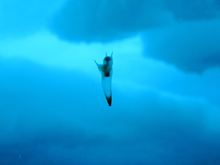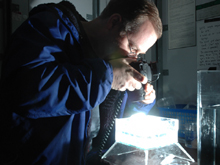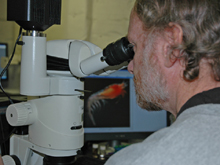
Clione, a shell-less snail known as the sea-butterfly, swims in the shallow waters beneath Arctic ice. Click image for larger view.
Many scientists on board the current Arctic expedition have poured a bit of their personal artistic side into documenting their scientific observations. These are just a few of the thousands of images collected during the expedition displaying the incredible beauty and diversity of life that exists in the remote Arctic Ocean..
![]() Click image to view a slide show.
Click image to view a slide show.
The Blending of Art and Science
July 25, 2005
Russ Hopcroft
Associate Professor
Institute of Marine Science, University of Alaska, Fairbanks
For many, science is an unfathomable topic. It is filled with numbers you cannot appreciate, strange words, foreign names of animal species, and drawings of things you cannot understand. As science becomes more advanced, we as scientists tend to loose a large proportion of the public we hope to educate.
The bottom line is that we as humans are visual creatures, and a picture is truly worth more than a thousands words. During this Arctic expedition, many of the scientists have strived to create a more visual record of what they have seen. A record we hope will be more readily understandable than hand drawn figures, graphs and tables. Many of us are excited by the organisms we study, and frequently, the line is blurred between creating a scientific record of our observations and the art of presenting nature.
In the early days of exploration, expeditions not only collected specimens but frequently enlisted artists to document the strange variety of life forms they encountered. Thus, the pictures they created carried a touch of artist's flare, and I remain impressed by some of the beautiful watercolor representation of plants and animals from that period (figure). Such pictures often captured the public's imagination. At the same time, the use of artists sometimes led to distortions, inaccuracies, or misinterpretations of important anatomical features. At some point in the mid-20 th century this artist's form of documentation was abandoned for simpler black and white line drawings. While line-drawings were more accurate, they were not particularly exciting to the non-scientist. Photography never really caught on with the people who describe organisms (taxonomists) because it was not considered an accurate or informative means of documenting organisms.
What changed? The world went digital. Suddenly some biologists realized they had a means of easily documenting what they saw, and what they did. The internet provided a means of distribution. The Ocean Explorer web-site represents but one example of how this can be done.
It is difficult to appreciate the scale at which imagery has been collected on this expedition. During the cruise we have gathered more than 150 hours of high-definition undersea video from the ROV, now archived on tape with working copies on 8 Terabytes of hard disks. By my estimates, we have more than 8000 images of the seafloor from the photographic platform, nearly 3000 images of animals taken through microscopes, at least 5000 images of organisms taken by macro photography, and untold thousands of images of sampling and daily events on personal cameras. What you see on this web-site hardly scratches the surface of what has been recorded.
The expedition's teams will be pouring through the quantitative parts of this material for the next year. At the same time, many will be culling the more beautiful and unique images to help inform or educate YOU on the variety of life that inhabits this frozen habitat at the top of the world. In general, we have all done more then simply create technically useful images, we have tried to find the beauty in what we see and collect. While dead and preserved animals are relatively colorless and non-exciting, the majority of images on this cruise have been taken of live and undamaged specimens.
Within the pelagic team, we frequently stop to look at animals not because they are unknown to us, but because they are exquisite to behold. We have gone to great lengths to install collecting tools on the ROV that allow us to bring up fragile animals alive and intact. We have built specialized aquaria to house the animals in the Healy's cold-room once they are collected to facilitate further observation. The colors of live zooplankton can be vivid, and frequently we find ourselves carried away in the process of examining them shipboard. Kevin Raskoff, for example, fired off more than 300 images of our dumbo octopus within hours after it was collected on the last pelagic dive. I currently have more than 1500 images (16.5 GB) of images taken through my microscope. Many are taken purely for artistic purposes, taken at times when a more practical person would be asleep in their bunk. We hope such efforts help you appreciate the incredible diversity of life that exists in the most remote ocean, if you simply take the time to look.
Sign up for the Ocean Explorer E-mail Update List.



































